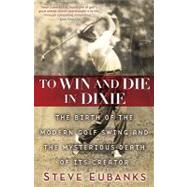
To Win and Die in Dixie : The Birth of the Modern Golf Swing and the Mysterious Death of Its Creator
by EUBANKS, STEVE-

This Item Qualifies for Free Shipping!*
*Excludes marketplace orders.
Rent Book
New Book
We're Sorry
Sold Out
Used Book
We're Sorry
Sold Out
eBook
We're Sorry
Not Available
Summary
Excerpts
August 8, 1921—a few minutes before midnight
Newspapering was a young man’s game. At least that was what Comer Howell told himself as he rolled his shoulders, put one foot on the running board, and unlatched the door of his Type 59 Cadillac. It was an odd and incongruous thought given that Comer was barely out of his teens and flush with promise. He had already studied abroad at Oxford and was only a few credits shy of a degree from the University of Georgia, but the pangs of another exhausting day reporting news for the Atlanta Constitution coupled with the suffocating heat of a Georgia summer night had zapped his vigor and left him feeling much older than his years.
With a tall, lean physique, a chiseled jaw, and perfectly slicked hair, he bore a remarkable resemblance to California’s latest moving picture sensation, an Italian named Rudolph Valentino. But Comer was no “Latin Lover” and certainly no play actor. With his chin high, a watch chain dangling from his vest pocket just so, the fingers of a hand relaxed in the pocket of his trousers, Comer looked like what he was: one of the Northsiders, the proper Atlantans who lived in the large neoclassical, Tudor-Jacobean, or colonial revival homes along the wooded northern hills of the South’s fastest-growing city. Atlanta had geographical as well as social demarcations. The hilly north side of town where oaks, magnolias, and dogwoods shaded the manicured lawns was the province of the right families, many wealthy, all white. The pine-laden flatlands grew progressively darker. The east side of town housed clusters of Orientals, Japanese and Chinese, who had migrated to the region as agricultural and railroad workers, and the southern enclaves were majority negro: areas someone like Comer Howell rarely visited, and never at this time of night.
He had removed his four-button jacket, a staple of the sacque suit, but too hot for August, even at midnight. He’d also loosened the silk tie, removing the clip and unfastening the collar of his white shirt, a faux pas bordering on scandalous in a town where lingering Edwardian mores required professional men to change clothes several times a day depending on the activity. Comer’s father certainly would have frowned on his casual appearance, but the elder Howell would just have to understand.
The thought of explaining his present wardrobe to anyone, especially his father, caused Comer’s shoulders to slump. He worked at the family newspaper and lived under his father’s roof (one of the largest Victorian dwellings on the north side) in the warm comfort of family largesse, but with those trappings came the heft of the Howell name. Maybe it was just the lateness of the hour: with Monday about to slip into Tuesday and his eyes burning from cigarette smoke and the strain of putting another day’s newspaper to bed, Comer couldn’t wait to get his car rolling uptown. Cadillac was one of the first automobiles with a venting system that blew air directly into the passenger compartment, and the Type 59, with its innovative tilted windshield, provided as comfortable an experience as one could find on the road. By all rights he was too young to be driving a luxury automobile, especially at a time when most Georgians still owned horses, or at least a mule, but along with the responsibilities of upholding the family reputation, being a Howell in Atlanta carried certain perks. Comer refused to feel guilty for indulging a few extravagances.
Of course, if he were such a big deal, why was he leaving the office at this hour, especially after going to press with such burning stories as the one about an eighty-year-old Atlantan who had fallen from a ladder in his yard?
He opened the door and waited on the running board while his passengers plopped into their seats. No matter the hour, Comer would never breach his Southern mann
An electronic version of this book is available through VitalSource.
This book is viewable on PC, Mac, iPhone, iPad, iPod Touch, and most smartphones.
By purchasing, you will be able to view this book online, as well as download it, for the chosen number of days.
Digital License
You are licensing a digital product for a set duration. Durations are set forth in the product description, with "Lifetime" typically meaning five (5) years of online access and permanent download to a supported device. All licenses are non-transferable.
More details can be found here.
A downloadable version of this book is available through the eCampus Reader or compatible Adobe readers.
Applications are available on iOS, Android, PC, Mac, and Windows Mobile platforms.
Please view the compatibility matrix prior to purchase.